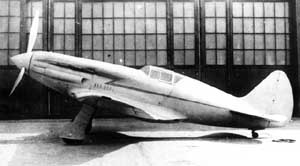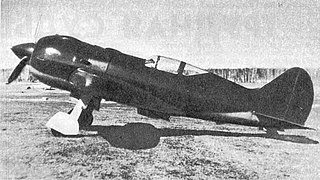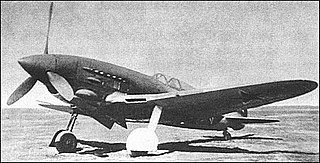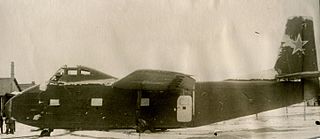Related Research Articles

The Mikoyan-Gurevich MiG-1 was a Soviet fighter aircraft of World War II that was designed to meet a requirement for a high-altitude fighter issued in 1939. To minimize demand on strategic materials such as aluminum, the aircraft was mostly constructed from steel tubing and wood. Flight testing revealed a number of deficiencies, but it was ordered into production before they could be fixed. Although difficult to handle, one hundred were built before the design was modified into the MiG-3. The aircraft was issued to fighter regiments of the Soviet Air Forces (VVS) in 1941, but most were apparently destroyed during the opening days of Operation Barbarossa, the German invasion of the Soviet Union in June 1941.

The Polikarpov I-185 was a Soviet fighter aircraft designed in 1940. It was flown with three engines but all of them were either insufficiently developed for service use or their full production was reserved for other fighters already in production. The I-185 program was cancelled on 27 January 1943.

The Polikarpov ITP was a Soviet fighter prototype designed during World War II. Development was prolonged by the evacuation of the design bureau forced by the German advance on Moscow in the fall of 1941. By the time the second prototype was finished the Soviets had fighters with equivalent or better performance already in production and the program was cancelled.

The Junkers Ju 322 Mammut was a heavy transport military glider, resembling a giant flying wing, proposed for use by the Luftwaffe in World War II; only two prototypes were completed, a further 98 were scrapped before completion.

The Heinkel He 46 was a German World War II-era monoplane designed in 1931 for the close reconnaissance and army co-operation roles. While it served with the Luftwaffe's front-line units only briefly at the start of World War II, the He 46 served as late as 1943 as a nighttime nuisance bomber and with the Hungarian Air Force.

The Gribovsky G-11 was a Soviet light troop/cargo military glider of World War II.

The Antonov A-7 was a Soviet light troop military glider of World War II.

The Yakovlev Yak-14 was the largest assault glider ever to enter service with the Soviet Air Force. It was introduced in 1949, at a time when other air forces were abandoning the glider concept. In 1950 a Yak-14 became the first glider to fly over the North Pole.

The Heinkel HD 37 was a fighter aircraft, designed in Germany in the late 1920s, but produced in the USSR for Soviet Air Force service. It was a compact, single-bay biplane with staggered wings of unequal span, braced by N-type interplane struts. The pilot sat in an open cockpit, and the main units of the tailskid undercarriage were linked by a cross-axle.

The Tupolev MTB-2, also known as the ANT-44, was a Soviet four-engine flying boat built in the late 1930s. Two prototypes were built; performance was satisfactory, but the design was overtaken by the fielding of long-range, land-based bombers by Soviet Naval Aviation and cancelled in 1940.

The Ilyushin Il-32 was a Soviet heavy military glider developed after World War II to deliver 7,000 kg (15,000 lb) of cargo. To facilitate loading and unloading, the glider's nose and tail sections were hinged to swing sideways. The Il-32 required a four-engined aircraft to tow it safely; it was canceled when it became clear that no such tug was going to be available after the Tupolev Tu-75 and Ilyushin Il-18 programs were both canceled because of shortages of their intended Shvetsov ASh-73 engines.

The Polikarpov VIT-1 was a Soviet twin-engined multi-purpose aircraft developed before World War II. One prototype was built in 1937, with an extremely heavy armament for ground attack duties. That was the only example built as it was decided to revise the design with more powerful engines as the VIT-2.
The Tomashevich Pegas was a World War II Soviet ground attack prototype aircraft built before the Battle of Kursk (1943), designed to destroy tanks and German vehicles.
The Tupolev ANT-10 was a prototype single-engined light bomber/reconnaissance aircraft of the 1930s. Only a single example was built, the Polikarpov R-5 being preferred.
The Polikarpov PM-1 was a passenger aircraft created by Polikarpov in the 1920s.
The Polikarpov MP was a Soviet transport aircraft developed by Polikarpov during World War II.
The Grigorovich ROM-1 was a long-range reconnaissance flying boat designed by the Grigorovich Design Bureau for the Soviet Navy in the late 1920s.
The Grigorovich MR-5 was a long-range reconnaissance flying boat designed by the Grigorovich Design Bureau for the Soviet Navy in the late 1920s.
The Grigorovich MRL-1 was a long-range reconnaissance flying boat designed by the Grigorovich Design Bureau for the Soviet Navy in the mid-1920s.
The BDP S-1 was a military glider of the Soviet Union. It was produced by the Bureau of Special Construction in 1941 as a glider infantry troop transport. It accommodated 20 troops plus one pilot, and had gun ports for defense. Of wooden construction, the glider featured a high aspect ratio, high-cantilever wing and trailing flaps, utilizing a wheeled-carriage for takeoff and landing on plywood runners Due to the advance of German forces, only seven were built until the factory was moved, and production was shifted to powered aircraft.
References
- 1 2 3 Gunston, Bill (1983). Aircraft of the Soviet Union : the encyclopaedia of Soviet aircraft since 1917. London: Osprey. pp. 252–253. ISBN 978-0850454451.